Taste
- sensations evoked by solutions in the mouth that contact the receptors on the tongue + roof of the mouth
retronasal olfactory sensation
- sensation of odor when chewing and swallowing
- forces an odorant in the mouth up behind the palate into the nose
flavor
- the combination of true taste (sweet, sour, bitter) and retronasal olfaction
Can not perceive taste BUT can perceive smell
-
Patient case: Damaged taste, but normal
olfaction—could
smell lasagna, but it had no flavor. -
Lab: Chorda tympani anesthetized
with lidocaine. -
Chorda tympani: The branch of cranial nerve VII
(the
facial nerve) that carries taste information from the
anterior, mobile tongue (the part you can stick out).
15.1 Taste versus Flavor 3
brain imaging studies
- Brain processes odors differently, depending on whether they come from nose or mouth
volatile compounds
- contribute greatly to retronasal olfaction.
- may
increase perceived sweetness without adding more sugar
-
Potential way to increase sweet flavor without adding
more calories.
-
Potential way to increase sweet flavor without adding
Taste buds
- Create neural signals conveyed to brain by taste nerves
- Are embedded in structures—papillae (bumps on
tongue) - Contain taste receptor cells
- Send information to brain via cranial nerves
Four kinds of papillae
- Filiform papillae:
- Fungiform papillae
- Foliate papillae
- Circumvallate papillae
Filiform papillae
- Small structures on the tongue that provide most of the bumpy appearance.
- Have no taste function
Fungiform papillae:
- Mushroom-shaped structures (maxdiameter 1 mm) distributed most
densely on edges of tongue,
- especially the tip.
- Average of six taste buds per papilla are buried in the surface.
Foliate papillae:
- Folds of tissue containing taste buds.
- Located on the
rear of the tongue lateral to the circumvallate papillae
- where the tongue attaches to the mouth.
Circumvallate papillae:
- Circular structures that form an inverted V on the rear of the
tongue
- three to five on each side
- Moundlike structures surrounded by a trench.
- Much larger than fungiform papillae.
Taste Myth: The Tongue Map
Hanid (1901)
measured taste thresholds at different parts of the tongue
Taste Myth: The Tongue Map
Boring (1942)
- replotted Hänig’s data and labeled it “sensitivity” instead of thresholds.
- The actual variations in the thresholds were
small,
- but Boring’s replotting made them look big
- but Boring’s replotting made them look big
Taste Myth: The Tongue Map
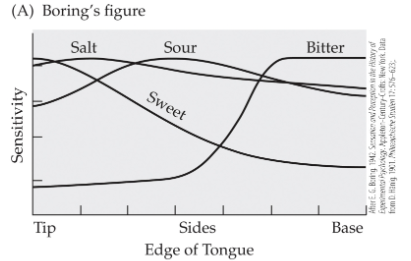
- Sweet, sour, salty, and bitter are tasted all over the tongue
- not just in the locations indicated by this scientific
urban legend
- not just in the locations indicated by this scientific
urban legend
Microvilli:
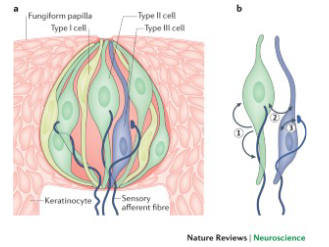
- Slender projections on the tips of some taste bud cells that extend into the taste pore.
- Contain the sites that bind to taste substances
- Not tiny hairs (as the name implies) // extensions of the cell membrane.
Tastant:
Any stimulus that can be tasted
Tastants can be divided into two large categories
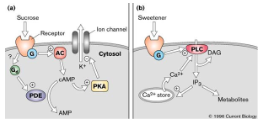
- Some are made up of small, charged particles that
taste salty or sour. (Small ion channels in microvilli membranes)- allow some types of charged particles to enter but
not
others.
- allow some types of charged particles to enter but
not
- perceived via G
protein-coupled receptors (GPCRs) similar to that in the olfactory
system.
- taste sweet or bitter.
Taste processing in the central nervous system
PATHWAY
- Taste buds to cranial nerves to medulla and thalamus and then to cortex
Taste processing in the central nervous system
Insular Cortex
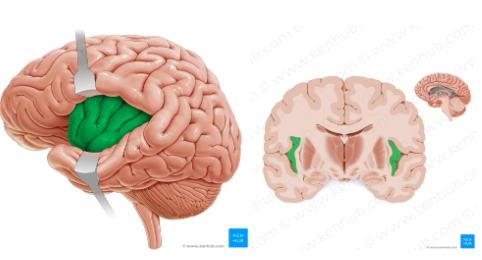
- Primary cortical processing area for taste.
- The part of the cortex that first receives taste information.
Taste processing in the central nervous system
Orbitofrontal cortex:
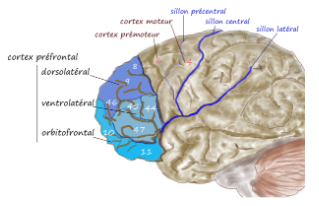
- The part of the frontal lobe of the cortex that lies above the
bone (orbit) containing the eyes.
- Receives projections from insular cortex
- Involved in processing of temperature,
touch, smell, and taste, (may be an integration area)
Inhibition:
Plays an important role in processing taste information in the brain
Inhibition Function
- To protect our whole mouth perception of taste when we have injuries to taste system.
- Descending inhibition from taste cortex blocks pain perception.
- survival value => we need to eat even if our mouth has been injured.
Four basic tastes
- Salty
- Sour
- Bitter
- Sweet
Salty
- made up of two charged particles: cation and anion.
- Ability to perceive is not static.
- Low-sodium diets = increase sensitivity to salty foods over time.
saltiness is not static
- Early experiences can modify salt preference
- Chloride-deficiency in childhood leads to an increased preference for salty foods later.
- Gestational experiences may affect liking for saltiness.
Sour
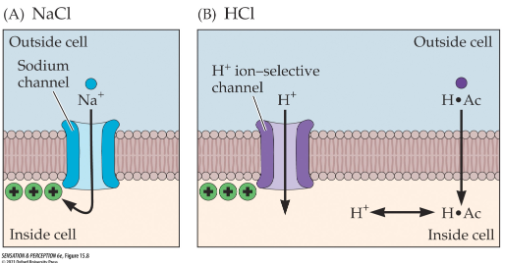
- Comes from acidic substances
- high acid concentrations = will damage both external and internal body tissues.
Quinine
Prototypically bitter-tasting substance.
Bitter
- Cannot distinguish between tastes of different bitter compounds.
- Many substances are poisonous.
- Ability to “turn off” bitter sensations—beneficial to liking certain vegetables.
- Bitter sensitivity is affected by hormone levels in women (intensifies during pregnancy)
Sweet
- Evoked by sugars.
- Many different sugars taste sweet.
- Glucose: Principle source of energy for most animals.
- Fructose: Even sweeter than glucose.
- Sucrose: Common table sugar; combination of glucose and fructose.
Sweet receptors
- Single receptor responsible for all sweet perception.
- Different sweeteners stimulate different parts
of
receptor. - Artificial sweeteners stimulate this receptor as well.
- Different sweeteners stimulate different parts
of
umami
- Candidate for fifth basic taste
- From monosodium glutamate (MSG)
- Glutamate: Important neurotransmitter
umami and safety
- Can lead to numbness, headache, flushing,
tingling,
sweating, and tightness in the chest- if sensitive individuals consume a large amount
- For most people, MSG does not pose a problem in small doses
fat
- important nutrient.
- Fat molecules evoke tactile sensations like oily, viscous, creamy, etc.
- Rats have fatty acid receptors on their tongues and humans may, too.
- Digesting fat in the gut produces conditioned preferences
for
the sensory properties of the food containing fat.
Arthur Fox (1931)
- discovered that phenylthiocarbamide (PTC) tastes dramatically different to different people.
- Bitter taste to some but not to others
- 1960s: Started using propylthioracil (PROP) instead of PTC because it is safer
Gene for PTC/PROP receptors
- discovered in 2003.
- Individuals with two recessive genes are non-tasters of PTC/PROP.
- Individuals with one or more of the genes are tasters of PTC/PROP.
Supertaster:
- Individual who is a taster of PTC/PROP and has a high density of fungiform papillae.
- Perceives the most intense taste sensations
Cross-modality matching:
- Ability to match the intensities of sensations that come from different sensory modalities.
- Used to assess intensity of taste sensations for nontasters, medium tasters, and supertasters
- Nontasters match the bitterness of PROP to the same intensity as the sound of a watch or a whisper.
Medium tasters match the bitterness of PROP
- same intensity as the smell of frying bacon or the pain of a mild headache
Supertasters match the bitterness of PROP
- same intensity as the brightness of the sun or the most intense pain ever experienced.
Health consequences of taste sensation
- Variations in sensory properties of foods and beverages affect
food preferences (diet)
- EX: some vegetables have a bitter
taste and so might be avoided by supertasters.
- EX: some vegetables have a bitter
taste and so might be avoided by supertasters.
- fats also taste bitter to supertasters => low fat food => lower risk of heart disease
Choose to eat/not eat
Smell
Helps us identify objects in the environment
Choose to eat/not eat
Taste
Helps us identify nutrients and antinutrients.
Survival value of taste
BItter
might signal poisons
Survival value of taste
Sour
configured to detect acidic solutions that might harm the body
Survival value of taste
Sweet and Salty
our bodies need sodium and sugar to survive
Babies and sweet food
evokes a “smilelike” expression followed by sucking.
babies with sour food
produces pursing and protrusion of lips
babies with bitter food
produces gaping, movements of spitting, and sometimes vomiting movements.
Specific hungers theory:
- The idea that deficiency of a given nutrient produces craving (a specific hunger) for that nutrient.
- Cravings for salty or for sweet = deficiencies in those substances
Modern theories also emphasize learning:
- We come to like or dislike foods based on the consequences of
eating
them. - “Evaluative conditioning”
- Foods with a positive or negative valence transfer to other neutral foods.
- We regulate our food through a combination of
hardwired tastes and learned responses
- from food flavors.
Cross-adaptation:
- When the taste of one food affects the taste of another.
- Example: A sour beverage tastes too sour after eating
a
sweet substance.
- Example: A sour beverage tastes too sour after eating
a
Orthonasal olfaction
- Olfaction through the nostrils.
- Do we learn to like or
dislike smells separately for
retronasal versus orthonasal olfaction?
- Example: Many people like the smell of
freshly cut
grass => don't want to eat it.
- Example: Many people like the smell of
freshly cut
Chili Peppers
- Acquisition of chili pepper preference depends on social influences.
- Restriction of liking to humans.
- Variability across individuals, depending on number of papillae
Capsaicin
The chemical that produces the burn in chilis; desensitizes pain receptors.
Desensitization (chili peppers)
- If a food is too hot for your palate, wait for the burn
to
subside after the first mouthful. - Your palate will
desensitize (from the capsaicin)
- you should be able to eat the rest of your meal.